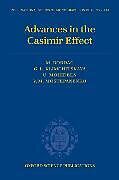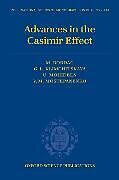Advances in the Casimir Effect
Einband:
Fester Einband
EAN:
9780199238743
Untertitel:
Englisch
Genre:
Physik & Astronomie
Autor:
Michael Bordag, Galina Leonidovna Klimchitskaya, Umar Mohideen, Vladimir Mikhaylovich Mostepanenko
Herausgeber:
Oxford Academic
Anzahl Seiten:
768
Erscheinungsdatum:
28.05.2009
ISBN:
978-0-19-923874-3
Zusatztext This is the first modern, comprehensive book on the Casimir effect, a very timely subject of growing importance and general appeal in physics. Although the Casimir effect has been an intriguing subject on its own right for more than half a century, it is experiencing a renaissance at the moment, because only fairly recently first precise measurements of the Casimir force have been made and because the Casimir effect is becoming important in nanotechnology. Informationen zum Autor Professor Umar Mohideen has held various positions at the University of California, Riverside, USA, and is now Vice-Chair of the Department of Physics and Astronomy there.Professor Galina Leonidovna Klimchitskaya began her career at the Leningrad State University, and is now Professor of the Department of Physics of the North-West Technical University (St.Petersburg, Russia). She has held visiting Professorships at Leipzig University, Germany; University of Paraiba, Joao Pessoa, Brazil; Central Brazilian Physical Institute, Rio de Janeiro, Brazil; and the University of California, Riverside, USA.Dr Michael Bordag has held a number of positions at the University of Leipzig, Germany, and currently lectures there.Professor Vladimir Mostepanenko is currently Principal Researcher of the Noncommercial Partnership ``Scientific Instruments'' (Moscow, Russia). He has held Visiting Professorships at Leipzig University, Germany; University of Paraiba, Joao Pessoa, Brazil; Central Brazilian Physical Institute, Rio de Janeiro, Brazil; and the University of California, Riverside, USA. Klappentext This book is a comprehensive sourcebook, distilled from hundreds of recently published papers, about the Casimir effect: the small forces originating from the quantum vacuum and acting between closely spaced bodies. It brings together developments in experiment and theory, fundamental and applied aspects of the Casimir force. Zusammenfassung The subject of this book is the Casimir effect, a manifestation of zero-point oscillations of the quantum vacuum resulting in forces acting between closely spaced bodies. For the benefit of the reader, the book assembles field-theoretical foundations of this phenomenon, applications of the general theory to real materials, and a comprehensive description of all recently performed measurements of the Casimir force with a comparison between experiment and theory. There is an urgent need for a book of this type, given the increase of interest in forces originating from the quantum vacuum. Numerous new results have been obtained in the last few years which are not reflected in previous books on the subject, but which are very promising for fundamental science and nanotechnology. The book is a unique source of information presenting a critical assessment of all the main results and approaches from hundreds of journal papers. It also outlines new ideas which have not yet been universally accepted but which are finding increasing support from experiment. Inhaltsverzeichnis 1: Introduction I: PHYSICAL AND MATHEMATICAL FOUNDATIONS OF THE CASIMIR EFFECT FOR IDEAL BOUNDARIES 2: Simple Models of the Casimir effect 3: Field quantization and vacuum energy in the presence of boundaries 4: Regularization and renormalization of the vacuum energy 5: The Casimir effect at nonzero temperature 6: Approximate and numerical approaches to the Casimir effect 7: The Casimir effect for two ideal metal planes 8: The Casimir effect in rectangular boxes 9: Single spherical and cylindrical boundaries 10: The Casimir force between objects of arbitrary shape 11: Spaces with non-Euclidean topology II: THE CASIMIR FORCE BETWEEN REAL BODIES 12: The Lifshitz theory of van der Waals and Casimir forces between plane dielectrics 13: The Casimir interaction between plates made of real metals at zero temperature 14: The Casimir interaction between real ...
Autorentext
Professor Umar Mohideen has held various positions at the University of California, Riverside, USA, and is now Vice-Chair of the Department of Physics and Astronomy there. Professor Galina Leonidovna Klimchitskaya began her career at the Leningrad State University, and is now Professor of the Department of Physics of the North-West Technical University (St.Petersburg, Russia). She has held visiting Professorships at Leipzig University, Germany; University of Paraiba, Joao Pessoa, Brazil; Central Brazilian Physical Institute, Rio de Janeiro, Brazil; and the University of California, Riverside, USA. Dr Michael Bordag has held a number of positions at the University of Leipzig, Germany, and currently lectures there. Professor Vladimir Mostepanenko is currently Principal Researcher of the Noncommercial Partnership ``Scientific Instruments'' (Moscow, Russia). He has held Visiting Professorships at Leipzig University, Germany; University of Paraiba, Joao Pessoa, Brazil; Central Brazilian Physical Institute, Rio de Janeiro, Brazil; and the University of California, Riverside, USA.
Klappentext
This book is a comprehensive sourcebook, distilled from hundreds of recently published papers, about the Casimir effect: the small forces originating from the quantum vacuum and acting between closely spaced bodies. It brings together developments in experiment and theory, fundamental and applied aspects of the Casimir force.
Zusammenfassung
The subject of this book is the Casimir effect, a manifestation of zero-point oscillations of the quantum vacuum resulting in forces acting between closely spaced bodies. For the benefit of the reader, the book assembles field-theoretical foundations of this phenomenon, applications of the general theory to real materials, and a comprehensive description of all recently performed measurements of the Casimir force with a comparison between experiment and theory. There is an urgent need for a book of this type, given the increase of interest in forces originating from the quantum vacuum. Numerous new results have been obtained in the last few years which are not reflected in previous books on the subject, but which are very promising for fundamental science and nanotechnology. The book is a unique source of information presenting a critical assessment of all the main results and approaches from hundreds of journal papers. It also outlines new ideas which have not yet been universally accepted but which are finding increasing support from experiment.
Inhalt
1: Introduction
I: PHYSICAL AND MATHEMATICAL FOUNDATIONS OF THE CASIMIR EFFECT FOR IDEAL BOUNDARIES
2: Simple Models of the Casimir effect
3: Field quantization and vacuum energy in the presence of boundaries
4: Regularization and renormalization of the vacuum energy
5: The Casimir effect at nonzero temperature
6: Approximate and numerical approaches to the Casimir effect
7: The Casimir effect for two ideal metal planes
8: The Casimir effect in rectangular boxes
9: Single spherical and cylindrical boundaries
10: The Casimir force between objects of arbitrary shape
11: Spaces with non-Euclidean topology
II: THE CASIMIR FORCE BETWEEN REAL BODIES
12: The Lifshitz theory of van der Waals and Casimir forces between plane dielectrics
13: The Casimir interaction between plates made of real metals at zero temperature
14: The Casimir interaction between real metals at nonzero temperature
15: The Casimir interaction between metal and dielectric
16: The Lifshitz theory of atom-wall interaction
17: The Casimir force between rough and corrugated surfaces
III: MEASUREMENTS OF THE CASIMIR FORCE AND THEIR APPLICATIONS IN BOTH FUNDAMENTAL PHYSICS AND NANOTECHNOLOGY
18:…

Leider konnten wir für diesen Artikel keine Preise ermitteln ...
billigbuch.ch sucht jetzt für Sie die besten Angebote ...
Die aktuellen Verkaufspreise von 6 Onlineshops werden in Realtime abgefragt.
Sie können das gewünschte Produkt anschliessend direkt beim Anbieter Ihrer Wahl bestellen.
Loading...
Die aktuellen Verkaufspreise von 6 Onlineshops werden in Realtime abgefragt.
Sie können das gewünschte Produkt anschliessend direkt beim Anbieter Ihrer Wahl bestellen.
| # | Onlineshop | Preis CHF | Versand CHF | Total CHF | ||
|---|---|---|---|---|---|---|
| 1 | Seller | 0.00 | 0.00 | 0.00 |
